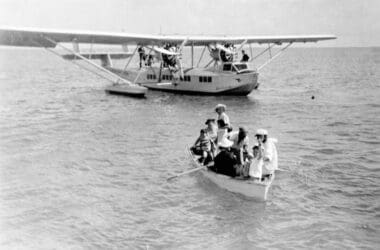A friend of mine said I should check out the Inflatoplane and quite frankly I thought he was joking. The whole notion seemed completely absurd, but it turns out it was a real thing.
Made by the Goodyear Aircraft Company who are responsible for the Goodyear Blimp, the Inflatoplane first flew on 12 February 1956. There were just 12 of these little planes built and you can see it in action below.
Inflatoplane Video
Following on from the last video about the British BAC One-Eleven, this time we head back across the Atlantic for a look at the Inflatoplane. The film runs just under five minutes and covers the period of August 1955 to February 1956.
With a wingspan of 22 feet and a maximum thickness of 12 inches, it is fun to see people literally standing on each wing to show how sturdy it is. Obviously this is not a passenger aircraft, as it just has room for the pilot.
It also amused me to see the entire contraption being wheeled around on a trolley by one person and apparently four people could assemble the aircraft in just ten minutes.
You can see the flight testing in the video, where they seem to be using a very large field. It could fly up to 600 kilometres and the idea was that it could be dropped behind enemy lines to rescue military personnel. Either way, it never went into service and the programme was halted in 1973.
Overall Thoughts
There are a couple of examples of the Inflatoplane in museums to go and see. The whole thing looks pretty dangerous all round and in fact one pilot was killed on a test flight. Either way, it would be kind of cool to whiz around in one of those things.
Did you know this existed? Are there any other strange or unusual aircraft you know about? Thank you for reading and if you have any comments or questions, please leave them below.
Enjoying the series? Check out the index to all the “Does Anyone Remember…” articles.
To never miss a post, follow me on Facebook, Twitter and Instagram.
All my flight and lounge reviews are indexed here so check them out!
Featured image via Wikimedia Commons.













Never heard of it before, great find!
Neither had I! A friend pointed it out to me and has then been hounding me to write a post about it since. I’m off the hook now!
If your review of the Premier Inn Manchester Deansgate Locks gets more reads than this amazing review then I’m a monkey’s uncle.
Hahahahahahahahahahahahahahaha!!!!!!!!!!!! I’ll run the stats at the end of the month and report back!